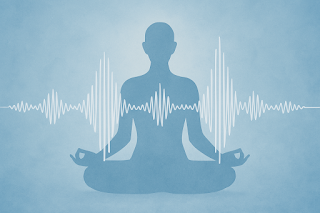The Role of Mantras in Deepening Meditation Practices
The Role of Mantra Meditation in Deepening Practices: Sound, Vibration, and Focus
Stuck in a traffic jam, mind racing, anxiety creeping in? What if a simple phrase could bring greater peace? That’s the power of meditation mantras. Beyond a yoga add-on, meditation mantras, sacred words or sounds all use vibration to shift consciousness, boost energy, and sharpen focus. Rooted in Sanskrit word traditions, they’re not just spiritual mantras for a spiritual leader, they’re tools for anyone seeking inner peace. Whether it’s a few deep breaths with “Om” or a guided meditation chanting Om Mani Padme Hum, mantras for meditation transform practicing meditation into something deeper. Let’s explore how sound and vibration work, try a meditation practice, and journal the benefits, all in pursuit of well-being.
What is a Mantra?
Definition and Purpose
A mantra is a word, sound, or phrase that is repeated during meditation to focus the mind and promote relaxation. Originating from ancient spiritual traditions, mantras are designed to alter one’s consciousness, cultivating mindfulness, reducing stress, and enhancing self-awareness. These sacred sounds can be derived from spiritual traditions like Hinduism and Buddhism or created personally to reflect individual beliefs and aspirations. The purpose of a mantra is to serve as a focal point for one’s attention during meditation, helping to quiet the mind and deepen the meditation experience. Whether it’s a traditional Sanskrit word or a personal affirmation, the power of a mantra lies in its ability to anchor the mind and foster a sense of inner peace.
How Sound and Vibration Shape Meditation
Mantra Meditation
Mantra meditation isn’t just repeating words, it’s a practice where sound becomes a focal point. Chanting a personal mantra like “Om” sends vibration through your body, calming the mind wanders moments and inviting relaxation. Studies show it can lower blood pressure and reduce stress, proof there’s health in the hum.
Om Mani Padme Hum
Take Om Mani Padme Hum, a Sanskrit word phrase from Tibetan Buddhism. Meaning “jewel in the lotus,” it’s a meditation mantra for compassion. Chant it aloud, and the vibration ripples, lifting energy and connecting you to the universe. People report greater peace after even a few minutes.
Meditation Practice
A solid meditation practice with mantras starts with breath. Inhale deeply, exhale your chosen mantra,it’s a rhythm that anchors you to the present moment. No right or wrong way, just repeat and feel the shift.
Meditation Mantra
A meditation mantra can be any word mantras that resonate. “So Hum” (I am that) syncs with breath—inhale “So,” exhale “Hum.” It’s a spiritual significance that steadies focus and calms the body.
Personal Mantra
Craft a personal mantra tied to personal beliefs. “I am enough” or “Peace flows through me” simple, meaningful phrases. Repeat silently or aloud; it’s your prayer for personal growth.
Right or Wrong Way
Worried there’s a right or wrong way? There isn’t. Meditate in a traffic jam or a quiet place, even a few minutes works. The important thing is to repeat and gently return when the mind wanders.
Selecting the Right Mantra
Choosing the right mantra for meditation is a deeply personal process that depends on your beliefs, values, and aspirations. When selecting a mantra, consider factors such as the sound and vibration it produces, its meaning and spiritual significance, and how easily it can be repeated. For instance, the mantra “Om Mani Padme Hum” is revered for its profound spiritual significance in Tibetan Buddhism, symbolizing compassion and the unity of wisdom and method. Other popular mantras include “Om Namah Shivaya,” which honors the divine within, and “Lam,” associated with grounding and stability. Experimenting with different mantras can help you find one that resonates with you on a personal level, fostering a deeper sense of inner peace and self-awareness. Ultimately, the best mantra is one that feels right for you and supports your meditation practice.
Mantras for Meditation
Mantras for meditation vary, different mantras suit different needs. “Om Shanti” (peace) for inner peace, “Ram” for strength. Pick good mantras that resonate with your life.
Reduce Stress
Chanting mantras can reduce stress. The vibration slows your pulse, easing anxiety. People report lower blood pressure and a relaxed state, health benefits in every sound.
Well Being
Well-being blooms with mantras. A little while of practicing meditation lifts energy, fosters mindfulness, and brings calm. It’s a balance for body and spirit.
Mind Wanders
When the mind wanders, and it will, gently return to your chosen mantra. No judgment, just repeat. It’s a sense of coming home to the present moment.
More Examples
Need more examples? “Aham Prema” (I am love), “Sat Nam” (truth is my name) each carries spiritual significance. Try them in guided meditation or solo.
Gently Return
The gently return habit is key. A few deep breaths, back to your mantra, it’s a practice of awareness. Over time, focus sharpens.
Using Mantras in Meditation Practice
Effective Techniques
To effectively use mantras in your meditation practice, start by finding a quiet and comfortable space where you can sit undisturbed. Set a timer for a few minutes to begin, and take a few deep breaths to calm your mind and body. Introduce your chosen mantra, repeating it silently or aloud, and focus on the sound and vibration it creates. If your mind starts to wander, gently redirect your attention back to the mantra and your breath. You can also experiment with different techniques, such as guided meditation sessions that incorporate mantras or repeating your mantra during daily activities like walking or cooking. Consistency is key to developing a meditation habit, so aim to practice regularly, even if it’s just for a few minutes each day. Over time, you’ll find that using mantras can enhance your focus, reduce stress, and bring a greater sense of inner peace.
The Science of Vibration and Consciousness
Sound and Vibration
Sound isn’t just noise, it’s vibration. Chanting sends waves through your body, syncing breath and brain. This energy shift can deepen consciousness, making mantra meditation a spiritual tool.
Consciousness Shift
How mantras affect consciousness ties to rhythm. Repeat silently, and the vibration quiets mental chatter, opening a sense of the universe. It’s awareness amplified.
Energy Boost
Vibration stirs energy. A particular mantra like “Om” vibrates your chest, waking your entire body. People report feeling lighter, more alive.
A Mantra Meditation Practice to Try
A 10-Minute Mantra Meditation Practice to Deepen Focus and Inner Stillness
This short but powerful practice uses repetition of sound to still the mind and reconnect with your inner self. Whether you’re new to mantra meditation or refining your practice, here’s a step-by-step guide that adds depth and clarity.
1. Set the Space (1 minute)
Choose a quiet, comfortable place where you won’t be disturbed. Sit upright, either cross-legged or in a chair with feet flat on the ground. Let your hands rest on your thighs or in your lap. Gently close your eyes or lower your gaze.
2. Ground Yourself with Breath (1 minute)
Begin with a few intentional breaths to center yourself. Inhale slowly through the nose, imagining calm filling your body. Exhale fully, releasing any tension or mental noise. Feel your seat connected to the earth and your spine rising with ease.
3. Choose a Mantra (30 seconds)
Pick a mantra that resonates with you. It can be a traditional Sanskrit sound like “Om”, meaning universal consciousness, or a personal affirmation like “I am present”, “Peace”, or “Let go.” Choose something meaningful that evokes a desired feeling or state of being.
4. Vocal Chanting (3 minutes)
Begin chanting your mantra aloud in a steady rhythm. Match the length of the mantra to your breath—don’t rush. Feel the vibration in your body as you speak. Allow the sound to anchor your awareness, drawing your attention inward.
5. Whisper Chanting (2 minutes)
Lower your volume to a whisper, just enough for you to hear yourself. This shift brings a more subtle focus. Let your breath remain calm and steady. Stay present with the sound and sensation of each repetition.
6. Silent Repetition (2.5–3 minutes)
Now internalize the mantra—repeat it silently in your mind. If your thoughts drift, gently return to the rhythm of the mantra. Let the repetition become effortless. Notice any sensations of stillness or spaciousness that arise.
7. Transition and Closing (30 seconds)
Stop repeating the mantra and sit quietly for a few breaths. Observe how you feel—lighter, calmer, more centered. End the practice by offering a silent blessing to yourself and the world: “May I be well. May all beings be well.”
Journaling to Deepen Your Mantra Experience
Reflect with these prompts:
-
How did my chosen mantra feel in my body?
-
Where did my mind wander, what brought it back?
-
What energy or calm did I notice after practicing meditation?
-
Which mantra resonates with my personal beliefs?
-
How can mantras for meditation fit my life?
Conclusion
The Role of Mantras in Deepening Meditation Practices lies in sound, vibration, and breath. From Om Mani Padme Hum to a personal mantra, they shift consciousness, spark energy, and refine focus. Chant in a quiet place, reduce stress in a traffic jam—it’s a practice for well-being. Try the meditation mantra, journal your awareness, and find greater peace. What phrase will you repeat today?










